How to Grow Mulberry: A Comprehensive Guide to Planting and Care
- March 20, 2024
- 2 comment
Learn how to grow mulberry trees with our comprehensive guide. Discover the step-by-step process from selecting the right variety to caring for mature plants, and enjoy the delicious fruits, ornamental beauty, and ecological benefits of mulberries.
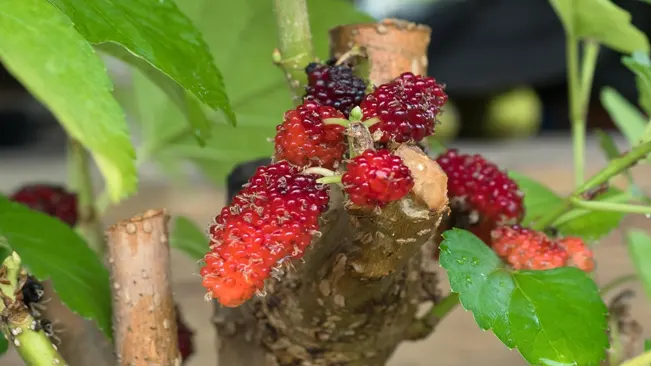
Benefits of Mulberry
| Benefits of Mulberries | Description |
|---|---|
| Nutrient-Rich | Mulberries are packed with essential nutrients including vitamin C, vitamin K, vitamin E, potassium, iron, and dietary fiber. |
| Antioxidant Properties | They contain anthocyanins, flavonoids, and resveratrol, powerful antioxidants that help neutralize free radicals and protect against chronic diseases. |
| Heart Health | Regular consumption of mulberries may lower cholesterol levels, reduce blood pressure, and improve cardiovascular health. |
| Digestive Health | The high fiber content in mulberries promotes healthy digestion, prevents constipation, and supports a balanced gut microbiome. |
| Immune Support | Vitamin C in mulberries strengthens the immune system, helping the body fight off infections and illnesses. |
| Anti-Inflammatory | Compounds like flavonoids and resveratrol exhibit anti-inflammatory properties, reducing inflammation and easing symptoms of inflammatory conditions. |
| Weight Management | The low calorie and high fiber content of mulberries make them a satisfying snack option that can aid in weight management and control hunger cravings. |
| Skin Health | Antioxidants in mulberries protect the skin from oxidative stress, promote collagen production, and contribute to a youthful complexion. |
| Bone Health | Vitamin K in mulberries plays a vital role in bone metabolism and may help prevent osteoporosis and maintain bone density. |
| Vision Protection | The presence of vitamin A and anthocyanins supports eye health, reduces the risk of age-related macular degeneration, and improves night vision. |
List on How To Grow Mulberry
- Selecting the Right Mulberry Variety
- Planting Mulberry Trees
- Mulberry Tree Care
- Harvesting Mulberries
Selecting the Right Mulberry Variety
Mulberry trees come in various species and cultivars, each with its unique characteristics. When selecting a mulberry variety, consider factors such as climate, space availability, and intended use (ornamental, fruit-bearing, or both). Common types include:
Morus alba (White Mulberry)
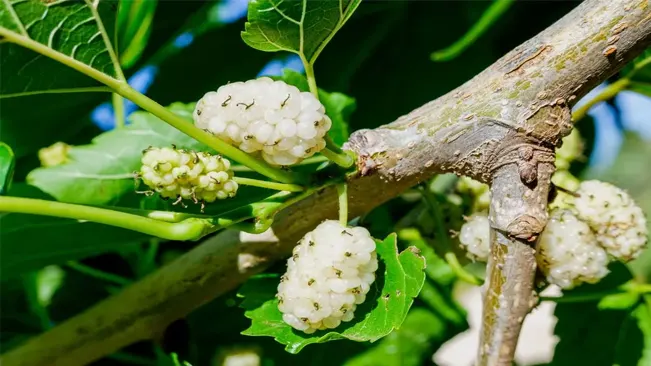
- Characteristics: White Mulberry trees are known for their rapid growth and adaptable nature. They typically reach heights of 30-50 feet, with a spreading canopy. The leaves are usually glossy green and lobed, providing a lush appearance.
- Fruit: White Mulberries produce sweet and juicy fruits that can vary in color from white to pink or purple when ripe. The fruits are generally smaller in size compared to Black Mulberries but are equally delicious.
- Climate and Growing Conditions: White Mulberry trees thrive in temperate climates with moderate rainfall and well-drained soil. They can tolerate a wide range of soil types, including sandy, loamy, or clay soils.
- Uses: White Mulberry trees are commonly grown for their ornamental value, providing shade and beauty to landscapes. The fruits are also edible and can be eaten fresh or used in various culinary applications, including jams, pies, and desserts.
Morus nigra (Black Mulberry)
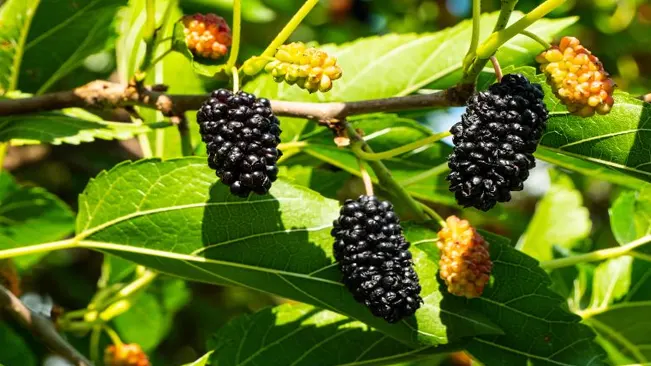
- Characteristics: Black Mulberry trees are known for their large, heart-shaped leaves and spreading growth habit. They can reach heights of 30-50 feet and have a wide canopy that provides ample shade.
- Fruit: Black Mulberries are prized for their rich, sweet flavor and dark-colored fruits. The berries are larger than those of White Mulberries and have a juicy, succulent texture. They are often used in cooking and are highly sought after for fresh consumption.
- Climate and Growing Conditions: Black Mulberry trees thrive in warm climates with ample sunlight and well-drained soil. They are more tolerant of heat and drought compared to other mulberry species and prefer slightly acidic to neutral soil conditions.
- Uses: Black Mulberry trees are primarily cultivated for their delicious fruits, which are enjoyed fresh or used in making jams, jellies, and wines. They also provide ornamental value and are often planted in parks and gardens for their attractive foliage and shade.
Morus rubra (Red Mulberry)
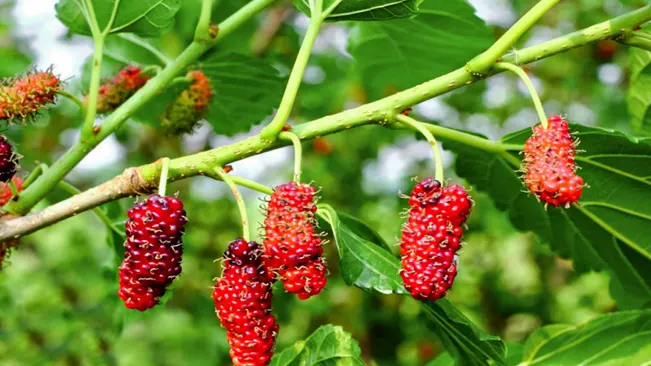
- Characteristics: Red Mulberry trees are native to North America and are well-adapted to various climates, including temperate and subtropical regions. They typically grow to heights of 30-40 feet and have a rounded crown with dark green, serrated leaves.
- Fruit: Red Mulberries produce sweet and flavorful berries that ripen to a dark red or purple color. The fruits are larger than those of White Mulberries and have a slightly tart flavor profile. They are highly valued for fresh consumption and culinary use.
- Climate and Growing Conditions: Red Mulberry trees are versatile and can thrive in a wide range of climates, from humid forests to dry uplands. They prefer moist, well-drained soil and can tolerate both acidic and alkaline soil conditions.
- Uses: Red Mulberry trees are valued for their fruit production as well as their ecological importance. They provide food for wildlife, including birds and small mammals, and contribute to biodiversity in natural habitats. Additionally, they are used in landscaping for their attractive foliage and shade-providing qualities.
Planting Mulberry Trees
Choosing a Suitable Location
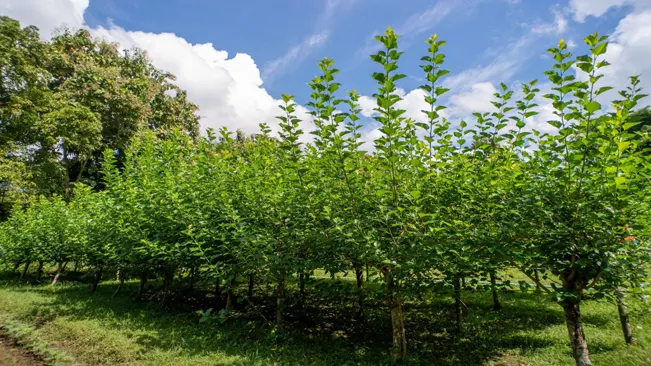
- Mulberry trees thrive in full sun, meaning they require at least 6-8 hours of direct sunlight daily. Select a location in your garden or landscape that receives ample sunlight throughout the day.
- Additionally, ensure the chosen location has well-drained soil to prevent waterlogging, which can lead to root rot and other problems. Avoid low-lying areas where water tends to accumulate.
- Consider the mature size of the mulberry tree and select a location away from buildings, structures, or other trees to accommodate its spreading canopy. This will prevent competition for sunlight and space as the tree grows.
Preparing the Soil
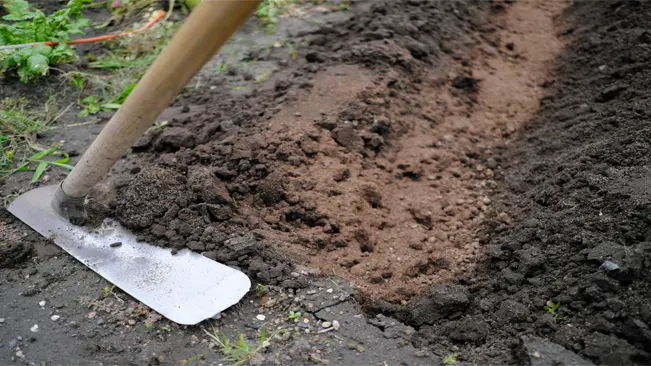
- Before planting, it’s essential to test the soil pH to determine its acidity or alkalinity level. Mulberry trees prefer soil with a pH ranging from slightly acidic to neutral (6.0-7.0). Soil pH testing kits are readily available at garden centers or can be conducted by agricultural extension services.
- If the soil pH is outside the ideal range, amendments may be necessary to adjust it. Adding lime can raise the pH of acidic soil, while sulfur or acidic fertilizers can lower the pH of alkaline soil.
- Incorporating organic matter such as compost, well-rotted manure, or peat moss into the soil can improve its fertility, structure, and drainage. Work the organic matter into the soil to a depth of at least 12 inches using a shovel or garden fork.
Planting

- Dig a hole that is twice as wide and slightly deeper than the root ball of the mulberry tree. This extra space allows the roots to spread out and establish more easily.
- Before planting, gently remove the mulberry tree from its container and inspect the root system. If the roots are tightly bound, gently tease them apart to encourage outward growth.
- Place the tree in the center of the prepared hole, ensuring that the root collar (the point where the roots meet the trunk) sits slightly above the surrounding soil level. Backfill the hole with the amended soil, pressing it down gently to eliminate air pockets.
- Water the newly planted tree thoroughly to settle the soil around the roots and provide essential moisture for establishment. Apply a layer of mulch around the base of the tree to help retain soil moisture and suppress weed growth.
Spacing
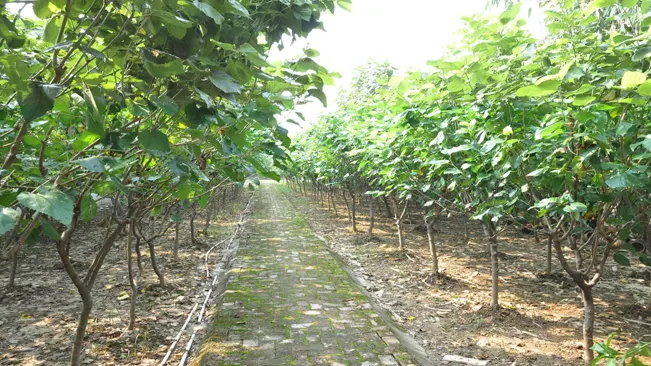
- Mulberry trees have a spreading growth habit, with mature trees reaching widths of 15-30 feet or more. To allow ample space for their expansive canopy and root system, plant mulberry trees at least 15-20 feet apart.
- Adequate spacing between trees also promotes good air circulation, which helps reduce the risk of fungal diseases and pest infestations. Avoid overcrowding by adhering to recommended spacing guidelines for optimal growth and development.
Mulberry Tree Care
Maintaining healthy mulberry trees requires regular attention to watering, fertilizing, pruning, and pest control:
Watering
- Newly planted mulberry trees require consistent moisture to establish their root systems. During the first growing season, water deeply at least once a week, ensuring the soil remains evenly moist but not waterlogged. Use a soaker hose or drip irrigation system to deliver water directly to the root zone. Mulberries are drought-tolerant once established but still benefit from supplemental irrigation during prolonged dry periods.
Fertilization
- In early spring, before new growth emerges, apply a balanced fertilizer formulated for fruit trees. Use a fertilizer with a nitrogen-phosphorus-potassium (NPK) ratio of around 10-10-10 or similar. Follow the manufacturer’s instructions for dosage rates based on the tree’s age and size. Avoid excessive nitrogen fertilization, as it can promote vegetative growth at the expense of fruit production.
Pruning
- Annual pruning is essential for maintaining the health, shape, and productivity of mulberry trees. Prune during the dormant season (late winter to early spring) before new growth begins. Remove dead, damaged, or diseased branches using sharp, clean pruning tools. Thin out crowded branches to improve air circulation within the canopy and reduce the risk of fungal diseases. Additionally, prune to shape the tree and control its size, especially if space is limited.
Pest and Disease Management
- Pests: Common pests that may infest mulberry trees include aphids, caterpillars (such as the mulberry looper), scale insects, and spider mites. Inspect the leaves, branches, and fruit for signs of infestation, such as feeding damage, sticky honeydew residue, or visible insects. Treat infestations promptly with insecticidal soap, horticultural oil, or organic insecticides labeled for use on fruit trees.
- Diseases: Mulberry trees are susceptible to fungal diseases such as powdery mildew, leaf spot, and bacterial blight. Monitor the tree for symptoms such as white powdery patches on leaves, yellowing or browning of foliage, or dark lesions on branches. Prune out infected branches and remove fallen leaves to reduce disease spread. Apply fungicides as necessary, following label instructions carefully.
Harvesting Mulberries
Timing of Harvest
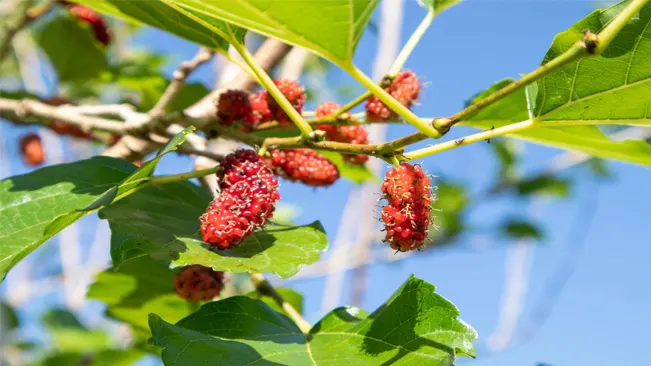
- Mulberries typically ripen from late spring to early summer, although the exact timing can vary depending on the variety and local climate. In warmer regions, mulberries may ripen earlier, while in cooler climates, they may ripen later in the season. It’s essential to monitor the fruits closely as they approach maturity to ensure you harvest them at the peak of flavor.
Indicators of Ripeness

- When mulberries are fully ripe, they undergo subtle changes in appearance and texture that indicate they’re ready for harvest. Look for fruits that have turned a deep, dark color—this can vary depending on the variety but often ranges from dark purple to black. Additionally, ripe mulberries will feel slightly soft to the touch, indicating their juiciness and sweetness.
Harvesting Technique

- To harvest mulberries, gently grasp the fruit between your thumb and forefinger and give it a slight twist. Ripe mulberries should come off the stem easily without much effort. Be careful not to squeeze the berries too hard, as they are delicate and can bruise easily. It’s best to harvest mulberries early in the morning when the temperatures are cooler, as the berries are firmer and less prone to damage.
Handling and Storage
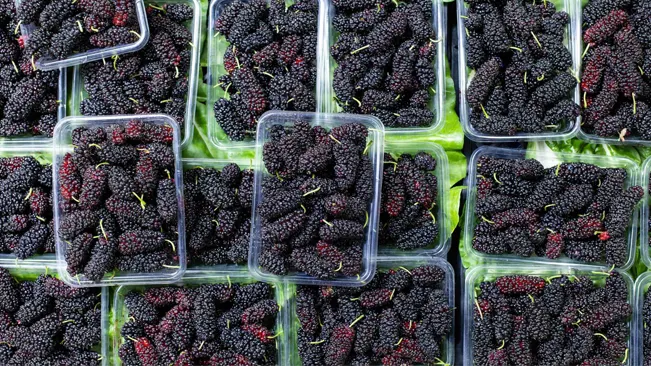
- After harvesting mulberries, handle them with care to prevent bruising and spoilage. Avoid stacking or piling the berries too high, as this can crush the delicate fruits. Instead, spread them out in a single layer in a shallow container or basket to allow for air circulation. Mulberries are highly perishable and should be consumed or processed promptly after harvesting. If you’re not using them right away, store them in the refrigerator for up to a few days, or freeze them for longer-term storage.
Culinary Uses

- Fresh mulberries are incredibly versatile and can be enjoyed in a variety of culinary applications. Eat them fresh as a healthy snack, add them to salads, cereals, or yogurt for a burst of flavor, or use them in baking to make pies, tarts, muffins, or cobblers. Mulberries also make delicious jams, jellies, syrups, and preserves that can be enjoyed year-round.
Related Post:
- How to Grow Ground Cherry: Simple Steps for Lush Growth
- How to Grow Spaghetti Squash: Your Thriving Garden Guide 2024
- How to Grow Runner Beans: A Comprehensive Guide for Bountiful Harvests
- How to Grow Jicama: Your Easy Guide to Cultivating the Mexican Yam Bean
- How to Grow Cinnamon Basil: A Beginner’s Guide to Aromatic Gardening
- How to Grow Roma Tomatoes: Expert Tips for a Lush Homegrown Harvest
- How to Grow Blackberries: Easy Steps to Grow and Nurture Your Own
Conclusion
Growing mulberry trees can be a fulfilling endeavor, offering not only a bountiful harvest of delicious fruits but also adding beauty and shade to your landscape. By selecting the right variety, providing proper care, and staying vigilant against pests and diseases, you can enjoy the benefits of mulberry cultivation for years to come. Whether you’re a backyard gardener or a commercial grower, incorporating mulberries into your garden can be a fruitful experience both literally and figuratively.
FAQs (Frequently Asked Questions)
- What type of soil do mulberry trees prefer?
- Mulberry trees thrive in well-drained soil with a pH ranging from slightly acidic to neutral (pH 6.0-7.0). They can tolerate various soil types, including loam, sandy loam, and clay, as long as the soil is well-drained.
- Mulberry trees thrive in well-drained soil with a pH ranging from slightly acidic to neutral (pH 6.0-7.0). They can tolerate various soil types, including loam, sandy loam, and clay, as long as the soil is well-drained.
- How much sunlight do mulberry trees need?
- Mulberry trees prefer full sun exposure to partial shade. They require at least 6-8 hours of direct sunlight daily for optimal growth and fruit production.
- Mulberry trees prefer full sun exposure to partial shade. They require at least 6-8 hours of direct sunlight daily for optimal growth and fruit production.
- When is the best time to plant mulberry trees?
- The best time to plant mulberry trees is in late fall or early spring when the trees are dormant. Planting during these seasons allows the trees to establish their root systems before the onset of active growth.
- The best time to plant mulberry trees is in late fall or early spring when the trees are dormant. Planting during these seasons allows the trees to establish their root systems before the onset of active growth.
- How often should I water mulberry trees?
- Newly planted mulberry trees require regular watering to establish root systems. Water deeply once or twice a week during the first growing season, especially during dry spells. Once established, mulberry trees are drought-tolerant and require less frequent watering.
- Newly planted mulberry trees require regular watering to establish root systems. Water deeply once or twice a week during the first growing season, especially during dry spells. Once established, mulberry trees are drought-tolerant and require less frequent watering.
- Do mulberry trees require pruning?
- Yes, mulberry trees benefit from annual pruning to maintain shape, remove dead or diseased wood, and promote air circulation within the canopy. Prune mulberry trees during the dormant season (late winter to early spring) to minimize stress on the tree.
- Yes, mulberry trees benefit from annual pruning to maintain shape, remove dead or diseased wood, and promote air circulation within the canopy. Prune mulberry trees during the dormant season (late winter to early spring) to minimize stress on the tree.
- How do I protect mulberry trees from pests and diseases?
- Monitor mulberry trees regularly for common pests such as aphids, caterpillars, and scale insects. Treat infestations promptly with insecticidal soap or horticultural oil. Additionally, watch for signs of diseases like powdery mildew or bacterial blight and take appropriate measures for control.
- Monitor mulberry trees regularly for common pests such as aphids, caterpillars, and scale insects. Treat infestations promptly with insecticidal soap or horticultural oil. Additionally, watch for signs of diseases like powdery mildew or bacterial blight and take appropriate measures for control.
- At what age do mulberry trees start bearing fruit?
- Mulberry trees typically start bearing fruit when they are 3-5 years old, depending on the variety and growing conditions. Some varieties may produce fruit earlier, while others may take longer to mature.
- Mulberry trees typically start bearing fruit when they are 3-5 years old, depending on the variety and growing conditions. Some varieties may produce fruit earlier, while others may take longer to mature.
- How do I harvest mulberries?
- Harvest mulberries when they are fully ripe, which is indicated by their dark color and slightly soft texture. Gently handpick the berries to avoid damaging the delicate fruit. Mulberries are best harvested in the morning when they are cool and less prone to bruising.
- Harvest mulberries when they are fully ripe, which is indicated by their dark color and slightly soft texture. Gently handpick the berries to avoid damaging the delicate fruit. Mulberries are best harvested in the morning when they are cool and less prone to bruising.
- Can I grow mulberry trees in containers?
- Yes, dwarf and semi-dwarf varieties of mulberry trees can be grown in containers, making them suitable for patios, balconies, or small gardens. Choose a large container with adequate drainage holes and use a well-draining potting mix.
- Yes, dwarf and semi-dwarf varieties of mulberry trees can be grown in containers, making them suitable for patios, balconies, or small gardens. Choose a large container with adequate drainage holes and use a well-draining potting mix.
- How do I propagate mulberry trees?
- Mulberry trees can be propagated from seeds, cuttings, or by grafting. Seeds can be collected from ripe fruits and sown in seed trays or directly in the ground. Cuttings can be taken from mature trees and rooted in a suitable growing medium. Grafting involves joining a scion (desired variety) to a rootstock for propagation.

Kristine Moore
Forestry AuthorI'm Kristine Moore, a seasoned garden landscaping professional with over 30 years of experience. My extensive career has been dedicated to transforming outdoor spaces into stunning, sustainable landscapes. With a deep understanding of horticulture, design principles, and environmental stewardship, I have become a respected figure in the field, known for creating harmonious, visually appealing, and eco-friendly gardens. My commitment to excellence and continuous learning in landscaping trends and techniques has solidified my reputation as an expert in garden design and implementation.













Helpful! I am growing a few Canadian dwarf mulberry plants.
Nancy S,
May 20, 2024 7:51 pmVery helpful article . Thank you
Charles M,
June 20, 2024 2:48 am